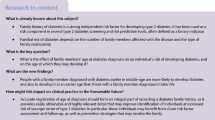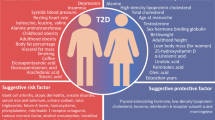Summary
We studied the cumulative incidence, concordance rate and heritability for diabetes mellitus in a nationwide cohort of 13,888 Finnish twin pairs of the same sex. The twins were born before 1958 and both co-twins were alive in 1967. Data on diabetes were derived through computerized record linkage from death certificates, the National Hospital Discharge Register and the National Drug Register. Records were reviewed in order to assign a diagnostic category to the 738 diabetic patients identified. Of these patients 109 had Type 1 (insulin-dependent) diabetes, 505 Type 2 (non-insulin-dependent) diabetes, 46 gestational diabetes, 24 secondary diabetes, 38 impaired glucose tolerance and 16 remained unclassified. The cumulative incidence of diabetes was 1.4 % in men and 1.3 % in women aged 28–59 years and 9.3 % and 7.0 % in men and women aged 60 years and over, respectively. The cumulative incidence did not differ between monozygotic and dizygotic twins. The concordance rate for Type 1 diabetes was higher among monozygotic (23 % probandwise and 13 % pairwise) than dizygotic twins (5 % probandwise and 3 % pairwise). The probandwise and pairwise concordance rates for Type 2 diabetes were 34% and 20% among monozygotic tiwns and 16% and 9 % in dizygotic twins, respectively. Heritability for Type 1 diabetes was greater than that for Type 2 where both genetic and environmental effects seemed to play a significant role.
Article PDF
Similar content being viewed by others
Avoid common mistakes on your manuscript.
References
Diabetes epidemiology research international (1987) Preventing insulin dependent diabetes mellitus: the environmental challenge. Br Med J 295: 479–481
Kirk RL, Serjeantson SW, King H, Zimmet P (1985) The genetic epidemiology of diabetes mellitus. Prog Clin Biol Res 194: 119–146
Then Berg H (1938) Die erbbiologie des diabetes mellitus. Arch Rass Ges Biol 32: 289–340
Harvald B, Hauge M (1963) Selection in diabetes in modern society. Acta Med Scand 173: 459–465
Gottlieb MS, Root HF (1968) Diabetes mellitus in twins. Diabetes 17: 693–704
Barnett AH, Eff C, Leslie RDG, Pyke DA (1981) Diabetes in identical twins: a study of 200 pairs. Diabetologia 20: 87–93
Newman B, Selby JV, King M-C, Slemenda C, Fabsitz R, Friedman GD (1987) Concordance for type 2 (non-insulin-dependent) diabetes mellitus in male twins. Diabetologia 30: 763–768
Committee on diabetic twins, Japan Diabetes Society (1988) Diabetes mellitus in twins: a cooperative study in Japan. Diabetes Res Clin Pract 5: 271–280
Pyke DA (1988) Development of diabetes in identical twins. In: Camerini-Davalos RA, Cole H (eds) Early diabetes: prediabetes. Plenum Press, New York, pp 255–258
Rich SS (1990) Mapping genes in diabetes. Genetic Epidemiological Perspective. Diabetes 39: 1315–1319
Romanov K, Koskenvuo M, Kaprio J, Sarna S, Heikkild K (1990) Selection bias in disease-related twin studies data on 11,154 adult Finnish twin pairs from a nationwide panel. Acta Genet Med Gemellol 39: 441–446
Diabetes epidemiology research international group (1988) Geographic patterns of childhood insulin-dependent diabetes mellitus: Diabetes 37: 1113–1119
Rewers M, LaPorte RE, King HOM, Tuomilehto J, for the diabetes epidemiology research international study group (DERI) (1988) Insulin-dependent diabetes mellitus in childhood: international patterns and trends. World Health Stat Q 41: 179–189
Reunanen A (1984) Prevalence and incidence of type II diabetes in Finland. Acta Endocrinol 5 [Suppl] 262: 31–35
Tuomilehto J, Nissinen A, Kiveld S-L et al. (1986) Prevalence of diabetes mellitus in elderly men aged 65 to 84 years in eastern and western Finland. Diabetologia 29: 611–6615
Koskenvuo M, Langinvainio H, Kaprio J, Ramasalo I, Sarna S (1979) The Finnish twin registry: baseline characteristics: section III: occupational and psychosocial factors. Publications of public health M49. University of Helsinki, Helsinki
Kaprio J, Sarna S, Koskenvuo M, Rantasalo I (1978) Baseline characteristics of the Finnish twin registry section II: history of symptoms and illnesses, use of drugs, physical characteristics, smoking, alcohol and physical activity. Publications of public health M37. University of Helsinki, Helsinki
Kaprio J, Sarna S, Koskenvuo M, Rantasalo I (1978) The Finnish twin registry: formation and compilation, questionnaire study, zygosity determination procedures and research program. Prog Clin Biol Res 24B: 179–184
Sarna S, Kaprio J, Sistonen P, Koskenvuo M (1978) Diagnosis of twin zygosity by mailed questionnaire. Human Hered 28: 241–254
Cederlöf R, Friberg L, Johansson E, Kaij L (1961) Studies on similarity diagnosis in twins with the aid of mailed questionnaires. Acta Genet Stat Med 11: 338–362
Harvald B, Hauge M (1965) Hereditary factors elucidated by twin studies. In: Nell JV, Shaw M, Schull WJ (eds) Genetics and the epidemiology of chronic disease. United States Department of Health, Education and Welfare, Washington, pp 61–76
Jablon S, Neel JV, Gershowitz H, Atkinson GF (1967) The NASNRC twin panel: methods of construction of the panel, zygosity diagnosis and proposed use. Am J Human Genet 19: 133–161
Kasriel J, Eaves LJ (1976) A comparison of the accuracy of written questionnaires with blood-typing for diagnosing zygosity in twins. J Biosocial Science 8: 263–266
Sarna S, Kaprio J (1979) Dependency of concordance probability on gene frequencies in genetic systems for the diagnosis of twin zygosity. Acta Genet Med Gemellol 28: 133–137
Laakso M, Reunanen A, Klaukka T, Aromaa A, Maatela J, Pyörälä K (1991) Changes in the prevalence and incidence of diabetes mellitus in Finnish adults. Am J Epidemiol 9: 850–857
Heliövaara M, Reunanen A, Aromaa A et al. (1984) Validity of hospital discharge data in a prospective study on stroke and myocardial infarction. Acta Med Scand 216: 309–316
World Health Organization study group report (1985) Diabetes mellitus. Technical reports series 727. WHO, Geneva
Sekar CC, Deming WE (1949) On a method of estimating birth and death rates and the extent of registration. Am Stat Assoc J 44: 101–115
Wittes JT, Colton T, Sidel VW (1974) Capture-recapture methods for assessing the completeness of case ascertainment when using multiple information. J Chronic Dis 27: 25–36
Smith C (1974) Concordance in twins: methods and interpretation. Am J Hum Genet 26: 454–466
Emery AEH (1986) Methodology in medical genetics. An introduction to statistical methods. Livingstone, Edinburgh, pp 55–56
Neale MC (1991) MX: statistical modelling. Medical College of Virginia, Department of Human Genetics
Heath AC, Neale MC, Hewitt JK, Eaves LJ, Fulker DW (1989) Testing structural equation models for twin data using LISREL. Behav Genet 19: 9–28
Neale MC, Heath AC, Hewitt JK, Eaves LJ, Fulker DW (1989) Fitting genetic models with LISREL: hypothesis testing. Behav Genet 19: 37–49
Tattersall RB, Pyke DA (1972) Diabetes in identical twins. Lancet II: 1120–1125
Olmos P, A'Hern R, Heaton DA et al. (1988) The significance of the concordance rate for type 1 (insulin-dependent) diabetes in identical twins. Diabetologia 31: 747–750
Kumar D, Gemayel NS, Gill SK et al. (1988) Type-specific concordance in young diabetic monozygotic twins. Adv Exp Med Biol 246: 259–267
Tuomilehto J, Lounamaa R, Tuomilehto-Wolf E et al. (1992) Epidemiology of childhood diabetes in Finland — background of a nationwide study of type 1 (insulin-dependent) diabetes mellitus. Diabetologia 35: 70–76
Johnston C, Pyke DA, Cudworth AG, Wolf E (1983) HLA-DR typing in identical twins with insulin-dependent diabetes: a difference between concordant and discordant pairs. Br Med J 286: 253–255
Millward BA, Alviggi L, Hoskins PJ et al. (1986) Immune changes associated with insulin dependent diabetes may remit without causing the disease: a study in identical twins. Br Med J 292: 793–796
Bell AE (1977) Heritability in retrospect. J Hered 68: 297–300
Kang KW, Christian JC, Norton JA Jr (1987) Heritability estimates from twin studies. I. Formulae of heritability estimates. Acta Genet Med Gemellol 27: 39–44
Falconer DS (1967) The inheritance of liability to diseases with variable age of onset, with particular reference to diabetes mellitus. Ann Hum Genet 31: 1–20
Simpson NE (1969) Heritabilities of liability to diabetes when sex and age at onset are considered. Ann Hum Genet (Lond) 32: 283–303
Degnbol B, Green A (1978) Diabetes mellitus among first- and second-degree relatives of early onset diabetics. Ann Hum Genet 42: 25–47
Cudworth A, Wolf E, Gorsuch A, Festenstein H (1979) A new look at HLA genetics with particular reference to Type 1 diabetes. Lancet II: 389–391
Tiwari JL, Terasaki PL (1985) HLA and disease associations. Springer, Berlin Heidelberg New York, p 185
Wolf E, Spencer KM, Cudworth AG (1983) The genetic susceptibility to Type 1 (insulin-dependent) diabetes: analysis of the HLA-DR association. Diabetologia 24: 224–230
Walker A, Cudworth AG (1980) Type 1 (insulin-dependent) diabetic multiplex families: mode of genetic transmission. Diabetes 29: 1036–1039
Wolf E (1988) Different linkage disquilibrium in Type 1 diabetic and “healthy” HLA haplotypes. In: Laron Z, Karp M (eds) Prognosis of diabetes in children. Pediatr Adolesc Endocrinol 18: 270–274
Kaprio J, Koskenvuo M, Langinvainio H, Romanov K, Sarna S, Rose RJ (1987) Genetic influences on use and abuse of alcohol: a study of 5638 adult Finnish twin brothers. Alc Clin Exp Res 11: 349–356
Rose RJ, Koskenvuo M, Kaprio J, Sarna S, Langinvainio H (1988) Shared genes, shared experiences, and similarity of personality: data from 14,288 adult Finnish co-twins. J Personal Soc Psychol 54: 161–171
Sellers TA, Kushi LH, Potter JD (1991) Can dietary intake patterns account for the familial aggregation of disease? Evidence from adult siblings living apart. Genet Epidemiol 8: 105–112
Tuomilehto J, Korhonen H, Kartovaara L et al. (1991) Prevalence of diabetes mellitus and impaired glucose tolerance in the middle-aged population of three areas in Finland. Int J Epidemiol 20: 1010–1017
Dahlquist G, Blom L, Tuvemo T, Nyström L, Sandström A, Wall S (1989) The Swedish childhood diabetes study — results from a nine year case register and a one year case-referent study indicating that type 1 (insulin-dependent) diabetes mellitus is associated with both type 2 (non-insulin-dependent) diabetes mellitus and autoimmune disorders. Diabetologia 32: 2–6
Author information
Authors and Affiliations
Rights and permissions
About this article
Cite this article
Kaprio, J., Tuomilehto, J., Koskenvuo, M. et al. Concordance for Type 1 (insulin-dependent) and Type 2 (non-insulin-dependent) diabetes mellitus in a population-based cohort of twins in Finland. Diabetologia 35, 1060–1067 (1992). https://doi.org/10.1007/BF02221682
Received:
Accepted:
Issue Date:
DOI: https://doi.org/10.1007/BF02221682




